Prenotrix 52.5 Microgram /H Transdermal Patch
PACKAGE LEAFLET: INFORMATION FOR THE USER
Read all of this leaflet carefully before
you start using this medicine.
• Keep this leaflet. You may need to read it again.
• If you have any further questions, ask your doctor or pharmacist.
• This medicine has been prescribed for you only. Do not pass it on to others. It may harm them, even if their signs of illness are the same as yours.
• If you get any of the side effects, talk to your doctor of pharmacist. This includes any possible side effects not listed in this leaflet. See section 4.
WHAT YOU NEED TO KNOW BEFORE YOU USE PRENOTRIX
Prenotrix
35 / 52.5 / 70 micrograms/h transdermal patch
Buprenorphine
WHAT IS IN THIS LEAFLET:
1. WHAT PRENOTRIX IS AND WHAT IT IS USED FOR
2. WHAT YOU NEED TO KNOW BEFORE YOU USE PRENOTRIX
3. HOW TO USE PRENOTRIX
4. POSSIBLE SIDE EFFECTS
5. HOW TO STORE PRENOTRIX
6. CONTENTS OF THE PACK AND OTHER INFORMATION

WHAT PRENOTRIX IS AND WHAT IT IS USED FOR
Prenotrix is an analgesic (a pain-relieving medicine) intended to relieve moderate to severe cancer pain and severe pain that has not responded to other types of painkillers.
Buprenorphine is an opioid (strong pain reliever), which reduces pain by acting on the central nervous system (specific nerve cells in the spinal cord and in the brain). Prenotrix is not suitable for the treatment of acute (short-lasting) pain.
Do not use Prenotrix
• if you are allergic (hypersensitive) to the active substance buprenorphine, soy, peanut or any of the other ingredients of this medicine (listed in section 6.);
• if you are dependent on strong pain relievers (opiods);
• if you suffer from a disease in which you have or may have great difficulty breathing;
• if you are taking monoamine oxidase (MAO) inhibitors (certain medicines used to treat depression) or you have taken this type of medicines in the last two weeks (see "Other medicines and Prenotrix");
• if you suffer from myasthenia gravis (a certain type of severe muscle weakness);
• if you suffer from delirium tremens ( confusion and trembling caused by abstinence from alcohol following habitual excessive drinking or occurring during an episode of heavy alcohol consumption)
Prenotrix must not be used to treat withdrawal symptoms in drug-dependent persons.
Warnings and precautions
Talk to your doctor or pharmacist before using Prenotrix
• if you have recently drunk a lot of alcohol;
• if you suffer from seizures or convulsions (fits);
• if your consciousness is disturbed (feeling light-headed or faint) for an unknown reason;
• if you are in a state of shock (cold sweat might be a sign of it);
• if the pressure in your skull is increased (for instance after head injury or in brain disease), and artificial respiration is not possible;
• if you have difficulty breathing or are taking other medicines that may make you breathe more slowly or weakly (see "Other medicines and Prenotrix");
• if your liver does not work properly;
• if you are inclined to abuse medicines or drugs.
Please consult your doctor if any of these statements apply to you or were applicable to you at any time in the past.
Also, please be aware of the following precautions:
• Some people may become dependent on strong pain relievers such as Prenotrix when they use them over a long period of time. They may have withdrawal effects when they stop using them (see "If you stop using Prenotrix").
• Fever and external heat may lead to larger quantities of buprenorphine in the blood than normal. Also, external heat may prevent the transdermal patch from sticking properly. Therefore, do not expose yourself to external heat (e.g. sauna, infra-red lamps, electric blankets, hot water bottles) and consult your doctor if you have fever
• Prenotrix is not recommended for persons below the age of 18 years, because the
product has not been studied in this age group.
• The use of the medicinal product can lead to positive results in the event of a doping test.
Other medicines and Prenotrix
Please tell your doctor or pharmacist if you are taking/using, have recently taken/used or might take/use or have recently taken any other medicines, including medicines obtained without a prescription.
• Prenotrix must not be used together with monoamine oxidase (MAO) inhibitors (certain medicines used to treat depression and parkinson's disease), or if you have taken this type of medicine for the last 2 weeks.
• Prenotrix may make some people feel drowsy, sick, or faint or make them breathe more slowly or weakly. These side effects may be intensified if other medicines that may produce the same effects are taken at the same time. These other medicines include other strong pain relievers (opioids), certain sleeping pills, anaesthetics, and medicines used to treat certain psychological diseases such as tranquillizers, anti-depressants, and neuroleptics. Some of these combinations in higher doses may cause serious problems with the breathing regulation in the brain - which may get life-threatening.
• If Prenotrix is used together with some medicines, the effects of the transdermal patch may be increased. These medicines include e.g. certain anti-infectives/anti-fungals (e.g. containing erythromycin or ketoconazole) or HIV medicines (e.g. containing ritonavir).
• If Prenotrix is used together with other medicines, the effects of the transdermal patch may be reduced. These medicines include certain products, e.g. dexamethasone; medicines to treat epilepsy (e.g. containing carbamazepine, or phenytoin) or medicines for tuberculosis (e.g. rifampicin).
Prenotrix with food and drink
You should not drink alcohol while using Prenotrix. Alcohol may intensify certain side effects of the transdermal patch and you may feel unwell. Drinking grapefruit juice may intensify the effects of Prenotrix.
Pregnancy and breast-feeding
If you are pregnant or breast-feeding, think you may be pregnant or are planning to have a baby, ask your doctor or pharmacist for advice before using this medicine.
Pregnancy
There is not sufficient experience regarding the use of Prenotrix in pregnant women. Therefore you should not use Prenotrix if you are pregnant.

HOWTO USE PRENOTRIX
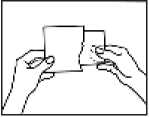
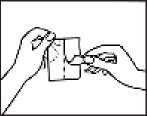
3. Peel off one half of the strip-foil of the transdermal patch and try not to touch the sticky part.
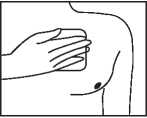
Breast-feeding
Buprenorphine, the active substance contained in the transdermal patch, inhibits milk formation and passes into the breast milk. Therefore, you should not use Prenotrix if you are breast-feeding.
Ask your doctor or pharmacist for advice before taking any medicine.
Driving and using machines
Prenotrix can affect your ability to drive and use machines as it may make you sleepy or dizzy. During treatment with Prenotrix do not drive or use machines, nor do so for at least 24 hours after the end of treatment.
• It is an offence to drive if this medicine affects your ability to drive.
• However, you would not be committing an offence if:
• Prenotrix has been prescribed to treat a medical or dental problem and;
• you have taken it according to the instructions given by the prescriber or in the information provided with the medicine and;
• it was not affecting your ability to drive safely
The effect on your ability to drive applies particularly:
• at the beginning of treatment,
• when you switch to Prenotrix from another pain reliever,
• if you also use other medicines that act on the brain,
• if you drink alcohol.
Talk to your doctor or pharmacist if you are not sure whether it is safe for you to drive while taking this medicine.
Prenotrix contains soya oil
If you are allergic to peanut or soya, do not use this medicinal product.
Always use this medicine exactly as your doctor or pharmacist has told you. Check with your doctor or pharmacist if you are not sure.
Prenotrix is available in three strengths: Prenotrix 35 micrograms/h transdermal patch, Prenotrix 52.5 micrograms/h transdermal patch and Prenotrix 70 micrograms/h transdermal patch.
The choice of which strength of Prenotrix will suit you best will be made by your doctor. During treatment your doctor may change which transdermal patch you use to a smaller or larger one if necessary.
Always use Prenotrix exactly as your doctor has told you. You should check with your doctor or pharmacist if you are not sure.
Route of administration
This patch is for transdermal use. Prenotrix acts through the skin. When transdermal patch is applied to the skin, the active substance buprenorphine passes through the skin into the blood.
The recommended dose is:
Adults
Unless your doctor has told you differently, attach one Prenotrix transdermal patch (as described in detail below) and change it after 3 days at the latest. To help you remember when to change your transdermal patch, you should make a note on the calendar on the outer packaging. If your doctor has advised you to take other pain relievers in addition to the transdermal patch, strictly follow the doctor's instructions, otherwise you will not fully benefit from treatment with Prenotrix.
Patients under 18 years of age
Prenotrix should not be used in persons below the age of 18 years, because no experience has so far been gained in this age group.
Elderly patients
No dosage adjustment is needed for elderly patients.
Patients with kidney disease / dialysis patients
In patients with kidney disease and in dialysis patients, no dosage adjustment is necessary.
Patients with liver disease
In patients with liver disease, the intensity and duration of action of Prenotrix may be affected. If this applies to you, your doctor will check on you more closely.
Instruction for opening of child resistant pouch
1 .Incise up to markings/arrowheads at each side 2.Rip at both notches along the heat-sealed joint 3.Open the pouch and take the patch
Method of administration
Before applying the transdermal patch
• Choose an area of skin which is flat, clean and hairless on your upper body, preferably on the chest below the collar-bone or on the upper part of the back. Call assistance if you cannot apply the transdermal patch yourself.
• If the chosen area has hairs, cut them off with a pair of scissors. Do not shave them off!
• Avoid skin which is red, irritated or has any other blemishes, for instance large scars
• The area of skin you choose must be dry and clean. If necessary, wash it with cold or lukewarm water. Do not use soap or other detergents. After a hot bath or shower, wait until your skin is completely dry and cool. Do not apply lotion, cream or ointment to the chosen area. This might prevent your transdermal patch from sticking properly
Applying the transdermal patch:
1. Please do not open the sachet, before you actually intend to use the transdermal patch. Each transdermal patch is sealed in a sachet.
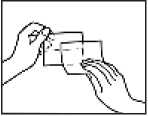
2. Start with peel off the loose separation foil.
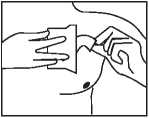
4. Stick the transdermal patch onto the area of skin you have chosen and remove the remaining foil.
5. Press the transdermal patch against your skin with the palm of your hand for 30 to 60 seconds. Make sure that the whole transdermal patch is in contact with your skin, especially at the edges.
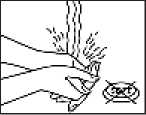
6. Wash your hands after using the transdermal patch. Do not use any cleansing products.
Wearing the transdermal patch You may wear the transdermal patch for up to 3 days. Provided that you have applied the transdermal patch correctly, there is little risk of it coming off. You may shower, bathe or swim while wearing it. However, do not expose the transdermal patch to extreme heat (e.g. sauna baths, infra-red lamps, electric blankets, hot water bottles).
In the unlikely event that your transdermal patch falls off before it needs changing, do not use the same transdermal patch again. Stick a new one on straight away (see "Changing the transdermal patch" below).
Changing the transdermal patch
• Take the old transdermal patch off.
• Fold it in half with the sticky sides inwards.
• Throw it away carefully,
• Stick a new transdermal patch on a different skin site (as described above). Wait at least one week before using the same skin site
Duration of treatment
Your doctor will tell you how long you may use Prenotrix. Do not stop using Prenotrix on your own account, because pain may return and you may feel unwell (see also "If you stop using Prenotrix" below).
If you have the impression that the effect of the Prenotrix transdermal patch is too weak or too strong, tell your doctor or pharmacist.
If you use more Prenotrix than you should
If this happens there may be signs of an overdose of the substance buprenorphine. An overdose may intensify the side effects of buprenorphine such as drowsiness, nausea and vomiting. You may get pin-point pupils and breathing may become slow and weak. You may also get cardiovascular collapse.
As soon as you discover that you have used more transdermal patch than you should, remove the excess transdermal patch and talk to a doctor or pharmacist.
If you forget to use Prenotrix
If you forgot an application, stick a new transdermal patch on as soon as you remember. If you are very late changing your transdermal patch, pain may return. In this case please contact your doctor.
Never apply twice the number of transdermal patches to make up for the forgotten application!
If you stop using Prenotrix
If you interrupt or finish using Prenotrix too soon, pain may return.
If you wish to stop use on account of unpleasant side effects, please consult your doctor. He/she will tell you what can be done and whether you can be treated with other medicines.
Some people may experience withdrawal-effects when they have used strong pain relievers for a long time and stop using them. The risk of having effects after you stop using Prenotrix is very low. However, if you feel agitated, anxious, nervous or shaky, if you are overactive, have difficulty sleeping or digestion problems, tell your doctor.
If you have any further questions on the use of this product, ask your doctor or pharmacist.
|
POSSIBLE SIDE EFFECTS | |
|
Like all medicines, Prenotrix can cause side effects, although not everybody gets them Side effects are classified as follows: | |
|
very common: |
may affect more than 1 in 10 people |
|
common: |
may affect up to 1 in 10 people |
|
uncommon: |
may affect up to 1 in 100 people |
|
rare: |
may affect up to 1 in 1,000 people |
|
very rare: |
may affect up to 1 in 10,000 people |
|
not known: |
frequency cannot be estimated from the available data |
The following side effects have been reported: Immune system disorders
Very rare: severe allergic reactions
Metabolism and nutrition disorders
Rare: loss of appetite
Psychiatric disorders
Uncommon: confusion, sleep disorder, restlessness
Rare: illusions such as hallucinations,
anxiety and nightmares, reduced sex drive
Very rare: dependence, mood swings
Nervous system disorders
Common: dizziness, headache
Uncommon: various degrees of sedation
(calmness), ranging from tiredness to muzziness
Rare: difficulty concentrating, speech
disorder, muzziness, disturbed balance, abnormal skin sensations (numbness, prickling or burning sensations)
Very rare: muscle twitching, taste disorders
Eye disorders
Rare: visual disturbance, blurred vision,
swollen eyelids
Very rare: pin-point pupils
Ear disorders
Very rare: ear pain
Heart and blood circulation disorders
Uncommon: circulation disorders (such as low blood pressure or, rarely, even circulatory collapse)
Rare: hot flushes
Chest and lung disorders
Common: shortness of breath
Rare: difficulty breathing (respiratory
depression)
Very rare: abnormally rapid breathing,
hiccups
Digestive system disorders
Very common: nausea (feeling sick)
Common: vomiting, constipation
Uncommon: dry mouth
Rare: heartburn
Very rare: retching
Skin disorders (generally at the site of application)
Very common: redness, itching
Common: skin changes (exanthema,
generally on repeated use), sweating
Uncommon: rash
Rare: hives
Very rare: pustules, small blisters
Urinary system disorders
Uncommon: difficulty in passing water,
urinary retention (less urine than normal)
Reproductive system disorders
Rare: erection difficulties
E
General disorders
Common: oedema (e.g. swelling of the
legs), tiredness
Uncommon: weariness
Rare: withdrawal symptoms (see
below), administration site reactions
Very rare: chest pain
If you notice any of the side effects listed above,
tell your doctor as soon as possible.
In some cases delayed allergic reactions occurred with marked signs of inflammation. In such a case you should stop using Prenotrix after you have talked to your doctor.
If you experience swelling of the hands, feet, ankles, face, lips, mouth or throat with may cause difficulty in swallowing and breathing, hives, fainting, yellowing of the skin and eyes (also called jaundice), remove the transdermal patch and call your doctor immediately or seek help at the casualty department of the nearest hospital. These can be symptoms of a very rare serious allergic reaction.
Some people may have withdrawal symptoms when they have used strong pain relievers for a long time and stop using them. The risk of having withdrawal effects when you stop using Prenotrix is low. However, if you feel agitated, anxious, nervous or shaky, if you are overactive, have difficulty sleeping or digestion problems, tell your doctor.
If any of the side effects gets serious, or if you notice any side effects not mentioned in this leaflet, please tell your doctor or pharmacist.
Reporting of side effects
If you get any side effects, talk to your doctor or pharmacist. This includes any possiblie side effects not listed in this leaflet. You can also report any side effects directly via Yellow Card Scheme fwww.mhra.gov.uk/yellowcard1.
By reporting side effects you can help provide more information on the safety of this medicine.

HOW TO STORE PRENOTRIX
Keep this medicine out of the sight and reach of children.
Do not use this medicine after the expiry date which is stated on the carton and the sealsachet (sealed bag). The expiry date refers to the last day of that month.
Open the sachet only in order to use the patch immediately.
Storage conditions: Do not store above 25°C.
Do not freeze.
Disposal of used or non-used transdermal patch
Used transdermal patches should be folded with the adhesive surface inwards and discarded or whenever possible returned to the pharmacy. Any unused medicinal product should be discarded or returned to the pharmacy.
CONTENTS OF THE PACK AND OTHER INFORMATION
What Prenotrix contains
The active substance is: Buprenorphine
Prenotrix 35 micrograms/h transdermal patch: Each transdermal patch contains 20 mg buprenorphine and releases about 35 micrograms of buprenorphine per hour. The area of the transdermal patch containing the active substance is 25 cm2.
Prenotrix 52.5 micrograms/h transdermal patch: Each transdermal patch contains 30 mg buprenorphine and releases about 52.5 micrograms per hour. The area of the transdermal patch containing the active substance is 37.5 cm2.
Prenotrix 70 micrograms/h transdermal patch: Each transdermal patch contains 40 mg buprenorphine releases about 70 micrograms per hour. The area of the transdermal patch containing the active substance is 50 cm2.
The other ingredients in Prenotrix are:
Drug containing adhesive matrix: styrene-butadiene-styrene (SBS) and styrene-butadiene block co-polymers, colophonium resin, antioxidants
(2,4-Bis(1,1-Dimethylethyl)phenyl phosphite (3:1); Tris(2,4-Di-Tert-Butylphenyl)phosphate), aloe vera leaf extract oil (also contains refined soya-bean oil and alpha tocopherol acetate).
Backing foil: pigmented polyethylene,
thermoplastic resin and aluminium vapour coated polyester, blue printing colour.
Release liner with pull of aid: polyester film, one side siliconised (to be removed prior application).
What Prenotrix looks like and contents of the pack
The patches are tan coloured, rectangular with four rounded edges and topped off corners and labeled with Buprenorphin 35 pg/h.
The patches are tan coloured, rectangular with four rounded edges and topped off corners and labeled with Buprenorphin 52.5 pg/h.
The patches are tan coloured, rectangular with four rounded edges and topped off corners and labeled with Buprenorphin 70 pg/h.
Each patch is packed in single sealed sachets. Prenotrix 35 micrograms/h is available in single
sealed sachets of 4, 5, 8, 10, 16, 20, 24 (6 x 4) transdermal patches.
Prenotrix 52.5 micrograms/h is available in single sealed sachets of 4, 5, 8, 10, 16, 20, 24 (6 x 4) transdermal patches.
Prenotrix 70 micrograms/h is available in single sealed sachets of 4, 5, 8, 10, 16, 20, 24 (6 x 4) transdermal patches.
Not all pack sizes may be marketed.
The following strengths of the patches are available:
Prenotrix 35 micrograms/h Prenotrix 52.5 micrograms/h Prenotrix 70 micrograms/h
Marketing Authorisation Holder:
Activase Pharmaceuticals Ltd,
11 Boumpoulinas, 3rd floor,
P.C. 1060 Nicosia, Cyprus
Manufacturer:
Acino AG,
Am Windfeld 35,
83714 Miesbach, Germany
This medicinal product is authorised in the Member States of the EEA under the following names:
DE Buprenorphin Acino 35 Mikrogramm/Stunde transdermales Pflaster Buprenorphin Acino 52,5 Mikrogramm/Stunde transdermales Pflaster Buprenorphin Acino 70 Mikrogramm/Stunde transdermales Pflaster
UK Prenotrix 35 microgram/h transdermal patch Prenotrix 52.5 microgram/h transdermal patch
Prenotrix 70 microgram/h transdermal patch
ES Canur 35 pg/h Parche transdermico Canur 52,5 pg/h Parche transdermico Canur 70 pg/h Parche transdermico
This leaflet was last revised in 07/2015.
A0130-0131 -0132/0/PIL7G2